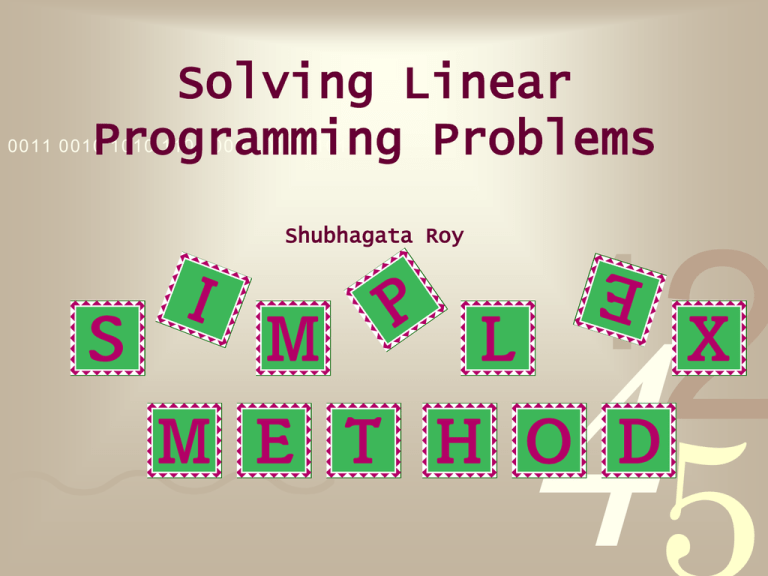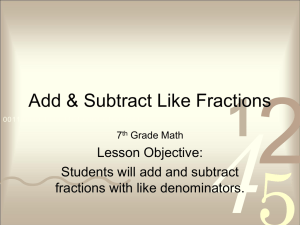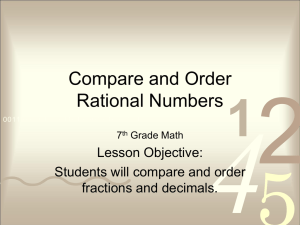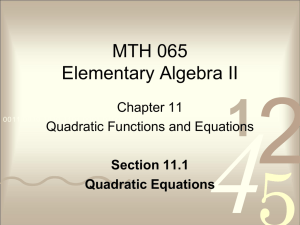SIMPLEX ALGORITHM
advertisement

Solving Linear Programming Problems 0011 0010 1010 1101 0001 0100 1011 Shubhagata Roy 1 2 4 Q. What is a Linear Programming Problem? 0011 0010 1010 1101 0001 0100 1011 A. A Linear Programming Problem(LPP) is a problem in which we are asked to find the maximum (or minimum) value of a linear objective function Z = aX1 + bX2 + cX2 + ... (e.g. Z = 3X1 + 2X2 + X3) Subject to one or more linear constraints of the form AX1+ BX2 + CX3 + . . <or= N (e.g. X1 + X2 + 3X3 <or= 12) The desired largest (or smallest) value of the objective function is called the optimal value, and a collection of values of X1,X2,X3, . . . that gives the optimal value constitutes an optimal solution.The variables X1, X2, X3, . . are called the decision variables. 1 2 4 Simplex Method The most frequently used method to solve LP problems is the Simplex Method. Before going into the method, we must get familiarized with some important terminologies : 0011 0010 1010 1101 0001 0100 1011 Standard Form- A linear program in which all the constraints are written as equalities. Slack Variable- A variable added to the LHS of “Less than or equal to” constraint to convert it into an equality. Surplus Variable- A variable subtracted from the LHS of “More than or equal to” constraint to convert it into an equality. Basic Solution- For a system of m linear equations in n variables (n>m),a solution obtained by setting (n-m) variables equal to zero and solving the system of equations for remaining m variables. Basic Feasible Solution(BFS)- If all the variables in basic solution are more than or equal to zero. 1 2 4 Optimum Solution- Any BFS which optimizes(maximizes or minimizes) the objective function. Tableau Form- When a LPP is written in a tabular form 0011 0010to 1010 1101 up 0001 0100 1011Simplex Tableau. prior setting the Initial Simplex Tableau- A table which is used to keep track of the calculations made at each iteration when the simplex method is employed. Net EvaluationRow(Cj-Zj )- The row containing net profit or loss.The nos.in this row are also known as shadow prices. Pivotal Column- The column having largest positive(or negative) value in the Net Evaluation Row for a maximization(or minimization) problem. Pivotal Row- The row corresponding to variable that will leave the table in order to make room for another variable. Pivotal Element- Element at the intersection of pivotal row and pivotal column. 1 2 4 To understand the method,let us take an example containing two decision variables and two constraints. Example: Maximize Z = 7X1+5X2 , subject to the constraints, 0011 0010 1010 1101 0001 0100 1011 X1+2X2 < or = 6 4X1+3X2 < or = 12 and X1 & X2 are non-negative. Step1: Convert the LP problem into a system of linear equations. 1 2 We do this by rewriting the constraint inequalities as equations by adding new "slack variables" and assigning them zero coefficients(profits) in the objective function as shown below: X1+2X2+S1 =6 4X1+3X2 +S2 = 12 And the Objective Function would be: Z=7X1+5X2+0.S1+0.S2 4 Step 2: Obtain a Basic Solution to the problem. We do this by putting the decision variables X1=X2=0, so that S10010 = 6 1010 and 1101 S2=12. 0011 0001 0100 1011 These are the initial values of slack variables. Step 3: Form the Initial Tableau as shown. Cj Basic Basic CB Variable Soln(XB) (B) 0 S1 6 0 S2 12 Zj (Net Evaluation)Cj - Zj Initial Tableau 7 5 0 X1 X2 S1 1 4 0 7 2 3 0 5 1 0 0 0 0 1 2 Min.Ratio (XB/Pivotal Col.) 4 S2 0 1 0 0 6/1=6 12/4=3 Step 4: Find (C -Z ) having highest positive value. j 0100 j 0011 0010 1010 1101 0001 1011 The column corresponding to this value,is called the Pivotal Column and enters the table. In the previous table,column corresponding to variable X1 is the pivotal column. 1 Step 5: Find the Minimum Positive Ratio. 2 Divide XB values by the corresponding values of Pivotal Column.The row corresponding to the minimum positive value is the Pivotal Row and leaves the table. In the previous table,row corresponding to the slack variable S2 is the pivotal row. 4 Step 6: First Iteration or First Simplex Tableau. In the new table,we shall place the incoming variable(X1) instead of the outgoing variable(S2). Accordingly,new values of 0011 0010 1010 1101 0001 0100 1011 this row have to be obtained in the following way : R2(New)=R2(Old)/Pivotal Element = R2(Old)/4 R1(New)=R1(Old) - (Intersecting value of R1(Old) & Pivotal Col)*R2(New) =R1(Old) - 1*R2(New) CB 0 7 Basic Variable (B) S1 X1 Cj 7 5 0 Basic Soln(XB) X1 X2 S1 0 1 7 0 54 3/4 21 4 - 1/4 1 0 0 0 3 3 Zj (Net Evaluation)Cj - Zj 0 1 2 4 S2 - 1/4 1/4 74 -74 Min.Ratio (XB/Pivotal Col.) Step 7: If all the (Cj-Zj) values are zero or negative,an optimum point is reached 0011 0010 1010 1101repeat 0001 0100the 1011process as given in otherwise Step 4,5 & 6. Since all the (Cj-Zj) values are either negative or zero,hence an optimum solution has been achieved.The optimum values are: X1=3, X2=0 and, Max Z=21. 1 2 4 Big-M Method of solving LPP The Big-M method of handling instances with artificial variables is the “commonsense approach”. Essentially, the 0011 0010 1010 1101 0001 0100 1011 notion is to make the artificial variables, through their coefficients in the objective function, so costly or unprofitable that any feasible solution to the real problem would be preferred....unless the original instance possessed no feasible solutions at all. But this means that we need to assign, in the objective function, coefficients to the artificial variables that are either very small (maximization problem) or very large (minimization problem); whatever this value,let us call it Big M. In fact, this notion is an old trick in optimization in general; we simply associate a penalty value with variables that we do not want to be part of an ultimate solution(unless such an outcome Is unavoidable). 1 2 4 Indeed, the penalty is so costly that unless any of the respective variables' inclusion is warranted algorithmically, such variables never part of any feasible solution. 0011 0010 1010 1101will 0001 0100 be 1011 This method removes artificial variables from the basis. Here, we assign a large undesirable (unacceptable penalty) coefficients to artificial variables from the objective function point of view. If the objective function (Z) is to be minimized, then a very large positive price (penalty, M) is assigned to each artificial variable and if Z is to be minimized, then a very large negative price is to be assigned. The penalty will be designated by +M for minimization problem and by –M for a maximization problem and also M>0. 1 2 4 Example: Minimize Z= 600X1+500X2 subject to constraints, 2X1+ X2 >or= 80 0011X0010 1010 110160 0001 1011 1+2X 2 >or= and0100 X1,X 2 >or= 0 Step1: Convert the LP problem into a system of linear equations. We do this by rewriting the constraint inequalities as equations by subtracting new “surplus & artificial variables" and assigning them zero & +M coefficientsrespectively in the objective function as shown below. So the Objective Function would be: Z=600X1+500X2+0.S1+0.S2+MA1+MA2 subject to constraints, 2X1+ X2-S1+A1 = 80 X1+2X2-S2+A2 = 60 X1,X2,S1,S2,A1,A2 >or= 0 1 2 4 Step 2: Obtain a Basic Solution to the problem. We do this by putting the decision variables X1=X2=S1=S2=0, so that A1= 80 and A2=60. These are the initial values of artificial variables. 0011 0010 1010 1101 0001 0100 1011 Step 3: Form the Initial Tableau as shown. Cj Basic Basic CB Variab Soln(XB) le (B) M M A1 A2 80 60 600 X1 500 X2 2 1 1 2 Zj 3M 3M Cj - Zj 600-3M 500-3M 0 0 S1 S2 -1 0 M M 0 -1 M M 1 M M 2 Min.Ratio (XB/Pivotal Col.) 4 A1 A2 1 0 M 0 0 80 1 60 M 0 It is clear from the tableau that X2 will enter and A2 will leave the basis. Hence 2 is the key element in pivotal column. Now,the new row operations are as follows: 0011 0010 1010 1101 0001 0100 1011 R2(New) = R2(Old)/2 R1(New) = R1(Old) - 1*R2(New) Cj 600 500 0 1 2 - 1/2 1 0 100/3 60 M M/2-250 M M 250-M/2 0 X2 S1 M 500 3 2 1 2 0 1 -1 0 500 0 Zj 3M/2+250 Cj - Zj 350-3M/2 2 A1 X1 50 30 1 M Min.Ratio (XB/Pivota l Col.) Basic Basic CB Variab Soln(XB) le (B) A1 X2 0 S2 4 It is clear from the tableau that X1 will enter and A1 will leave the basis. Hence 2 is the key element in pivotal column. Now,the new row operations are as follows: 0011 0010 1010 1101 0001 0100 1011 R1(New) = R1(Old)*2/3 R2(New) = R2(Old) – (1/2)*R1(New) Cj CB 600 500 Basic Varia Basic ble Soln(XB) (B) X1 X2 100/3 40/3 Zj Cj - Zj 600 500 0 X1 X2 S1 1 0 600 0 1 500 0 2 3 1 3 700 3 700 3 0 1 0 2 Min. Ratio (XB/P ivotal Col.) 4 S2 1 3 2 3 400 3 400 3 Since all the values of (Cj-Zj) are either zero or positive and 1010 also1101 both0001 the 0100 artificial 0011 0010 1011 variables have been removed, an optimum solution has been arrived at with X1=100/3 , X2=40/3 and Z=80,000/3. 1 2 4 0011 0010 1010 1101 0001 0100 1011 1 2 4










